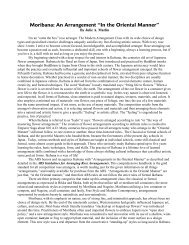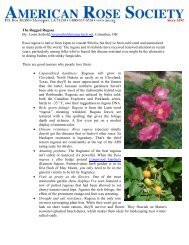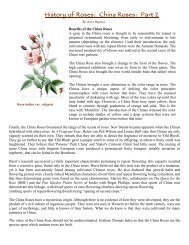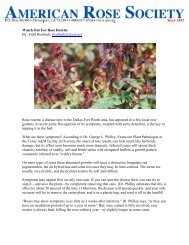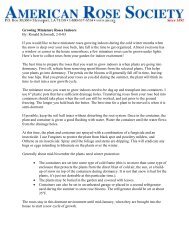Richard J. Anthony Brimfield, OH 44240 RJA4CPA@aol.com
Richard J. Anthony Brimfield, OH 44240 RJA4CPA@aol.com
Richard J. Anthony Brimfield, OH 44240 RJA4CPA@aol.com
You also want an ePaper? Increase the reach of your titles
YUMPU automatically turns print PDFs into web optimized ePapers that Google loves.
<strong>Richard</strong> J. <strong>Anthony</strong><br />
<strong>Brimfield</strong>, <strong>OH</strong> <strong>44240</strong><br />
<strong>RJA4CPA@aol</strong>.<strong>com</strong><br />
The rose Midge; Dasineura rhodophaga Cocquillett is <strong>com</strong>monly classified as an un<strong>com</strong>mon pest<br />
by most non-rosarians. Midge damage was first identified in 1886 in New Jersey. Since that time<br />
it has been found in most northeastern states and on both coasts. If you ask the serious exhibitor<br />
you will find that the Midge is actually much more <strong>com</strong>mon than most rose growers are aware<br />
of. This is primarily due to the fact that often Midge is either undetected or misdiagnosed. This is<br />
often the case among non exhibitor rose growers.<br />
Non exhibitor’s rosarians typically do not grow as many roses as exhibitors do and they usually<br />
do not spend the amount of time in the garden that most exhibitors spend. For those of you who<br />
have experienced the devastation that Midge can cause in a garden, you know exactly why I refer<br />
to the Midge as the exhibitor’s worst enemy. When damage is evident and not diagnosed<br />
correctly and taken care of immediately, Midge will wipe out all or most blooms in short order.<br />
What happens is the adult Midge will lay its eggs inside the sepal of an emerging flower. The<br />
tiny maggot (about 1/20 of an inch in length) that hatches will feed in this area and cause the tip<br />
of the flower to shrivel and darken or be<strong>com</strong>e distorted often with the bud turning to a forty five<br />
degree angle. If the problem is detected, diagnosed correctly and treated appropriately, it is<br />
normally brought under control rather quickly.<br />
Conversely, if undetected, misdiagnosed and left untreated the resultant devastation is not<br />
something you will want to experience. The life cycle of the Midge is quite short; about nine<br />
days from the time eggs hatch until a new set of eggs hatch new Midge. This is where the<br />
problem really presents itself as once the Midge gains a foothold it is very difficult to bring the<br />
problem under control as eggs continue to hatch and a new set of Midge is reproduced on<br />
average of about every nine days. It doesn’t take an accountant to see the exponential impact if<br />
left untreated; <strong>com</strong>plete eradication of blooms in the rose garden is the result.<br />
Now that I have sufficiently alarmed you please understand that all is not lost; an outbreak of<br />
Midge can be treated with success. I had a major Midge problem four years previous and<br />
unfortunately it cost me the entire fall rose show season due to it going undetected initially. To<br />
make matters worse I did not treat it properly in the beginning. What I did to successfully <strong>com</strong>bat<br />
Midge I will relate to you. I am not a chemist but rather a bean-counter who definitely<br />
understands the concepts of consistency and overkill.<br />
This is exactly what I did to <strong>com</strong>bat the problem. The one thing I took away from this experience<br />
is a very important lesson; consistency is the primary element in treating Midge as it is with most<br />
other rose related concerns. Once Midge was diagnosed and after doing extensive research, I was<br />
able to find a few bags of Diazinon which I quickly exhausted on 500+ rose bushes. This contact<br />
killer of insects was but the first step in my treatment program. My research suggested that any<br />
product that contained an ingredient identified as IMIDACLOPRID would work in reducing<br />
and/or eliminating the Midge. Several Bayer products contain the ingredient as does Merit which<br />
in my opinion just might be the better choice as it has a higher concentration of the ingredient.
In my less than humble opinion, the key to success is consistency as well as over kill. I used the<br />
Bayer granular product around the drip line to the tune of one cup per large flowered bush and<br />
one half cup for minifloras and miniature roses. I also used Merit as both a drench every week<br />
initially and as a spray every three days until I had buds setting without noticeable Midge<br />
damage; on average it takes one <strong>com</strong>plete bloom cycle to bring the problem under control. I<br />
alternated the Merit spray with other systemic and contact insecticides. I did this from mid<br />
August until October every three days for the spray and every other week for the drench after the<br />
first two applications. What worked? I have no idea to be quite honest but I was getting blooms<br />
in October after the initial treatment and the following spring I was able to resume exhibiting.<br />
As I indicated, I am a firm believer in consistency and over kill. While it might be nice to know<br />
which or what actually product or treatment actually worked best my primary concern was to<br />
eliminate the problem and this was ac<strong>com</strong>plished to my satisfaction. Another thing I have <strong>com</strong>e<br />
to accept is that Midge is almost always present and cannot be <strong>com</strong>pletely eliminated. It can be<br />
brought under control and if you are willing to accept an occasional shriveled up flower bud or a<br />
distorted or turned bud, I suggest you treat your roses at minimum two or three times a year.<br />
Doing so and Midge should not be a major cause of concern in the rose garden. I use the Bayer<br />
granules around the drip line in early May and again in mid August of each year along with<br />
spraying with Merit monthly. This has resulted in very few shriveled or turned buds in over 600<br />
roses this year and that is something I can live with.<br />
One thing about Midge that I have learned the hard way is to treat each new potted rose you<br />
receive whether it is a small rooted cutting or a mature potted plant with caution. Midge spend<br />
part of their life cycle in the ground and if you bring Midge into your garden via a new potted<br />
rose the potential exists to contaminate your entire garden if you do not treat the potted rose as if<br />
it is Midge contaminated.<br />
As I mentioned earlier in this article, I am a firm believer in overkill and this is but another<br />
example over overkill that works. To my way of thinking Midge is an exhibitors worst enemy<br />
and I am not about to relive what I experienced four years prior. Treat Midge with consistency<br />
and you should never have a concern about your roses.




